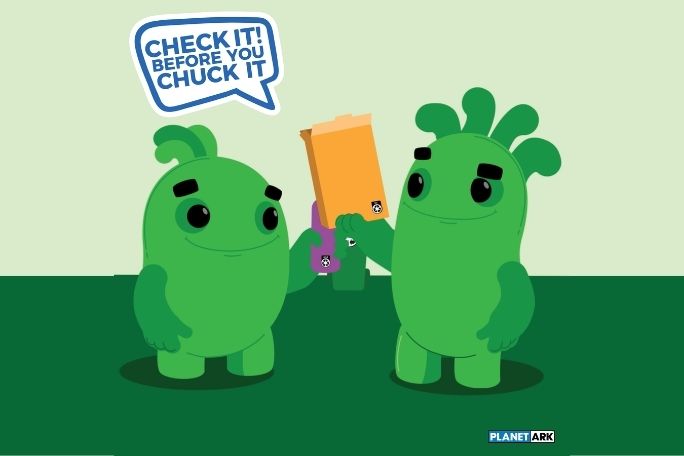Lesson summary
When we consider using and disposing of packaging, there are lots of options. Recycling is just one of the ways that we can recover valuable resources from packaging. Reducing our consumption of packaging and making more use of re-usable packaging is a preferable approach to reducing the consumption of valuable resources.
In this lesson students will explore the waste hierarchy and consider alternatives to recycling. They will critically evaluate their consumption of packaging and think creatively to come up with ways to reduce and re-use. Finally, they will apply their learning to a real world challenge by encouraging their family to change their consumption behaviours.
The lessons in this unit explore the purpose of the Australasian Recycling Label (ARL) and how to translate this understanding into environmental action. We recommend this lesson be used as part of a sequence of learning within this unit.
Learning intentions:
Students will...
- consider how to reduce their consumption of packaging products
- consider the features of re-usable and repurposable economies.
Success criteria:
Students can...
- critically evaluate their packaging consumption
- think creatively to reduce, re-use and repurpose their consumption of packaging.
Lesson guides and printables
Lesson details
Curriculum mapping
Australian Curriculum content descriptions:
Year 5 English:
- Plan, draft and publish imaginative, informative and persuasive print and multimodal texts, choosing text structures, language features, images and sound appropriate to purpose and audience (ACELY1704)
- Re-read and edit student’s own and others’ work using agreed criteria for text structures and language features (ACELY1705)
- Use a range of software including word processing programs with fluency to construct, edit and publish written text, and select, edit and place visual, print and audio elements (ACELY1707)
Year 6 English:
- Plan, draft and publish imaginative, informative and persuasive texts, choosing and experimenting with text structures, language features, images and digital resources appropriate to purpose and audience (ACELY1714)
- Re-read and edit students’ own and others’ work using agreed criteria and explaining editing choices (ACELY1715)
- Use a range of software, including word processing programs, learning new functions as required to create texts (ACELY1717)
Year 5 Science:
- Scientific knowledge is used to solve problems and inform personal and community decisions (ACSHE100)
Year 6 Science:
- Scientific knowledge is used to solve problems and inform personal and community decisions (ACSHE083)
Syllabus outcomes: EN3-2A, ST3-7PW
General capabilities: Literacy, Information and Communication Technology (ICT) Capability, Critical and Creative Thinking, Personal and Social Capability, Ethical Understanding
Cross-curriculum priority: Sustainability
Relevant parts of Year 5 Science achievement standards: Students create imaginative, informative and persuasive texts for different purposes and audiences. They make presentations which include multimodal elements for defined purposes. They contribute actively to class and group discussions, taking into account other perspectives. When writing, they demonstrate understanding of grammar using a variety of sentence types. They select specific vocabulary and use accurate spelling and punctuation. They edit their work for cohesive structure and meaning. Students discuss how scientific developments have affected people’s lives, help us solve problems and how science knowledge develops from many people’s contributions.
Relevant parts of Year 6 Science achievement standards: Students create detailed texts elaborating on key ideas for a range of purposes and audiences. They make presentations and contribute actively to class and group discussions, using a variety of strategies for effect. They demonstrate an understanding of grammar, and make considered vocabulary choices to enhance cohesion and structure in their writing. They use accurate spelling and punctuation for clarity and make and explain editorial choices based on criteria. Students explain how scientific knowledge helps us to solve problems and inform decisions and identify historical contributions.
This lesson is part of the wider unit of work Australasian Recycling Label
Time required: 55 mins
Level of teacher scaffolding: Medium – facilitate a class brainstorm, support students with literacy and ICT skills
Resources required
- Advocate pack – plastic pocket or display folder
- A device capable of presenting a video to the class
Skills
This lesson is designed to build students’ competencies in the following skills:
- Communication
- Community engagement
- Creativity
- Critical thinking
- Digital literacy
- Enterprise
- Ethical understanding
- Global citizenship
- Problem solving
- Social skills
- Collaboration
Additional info
This lesson has been developed as part of Planet Ark’s campaign around the Australasian Recycling Label and sustainable packaging. You can get involved during Planet Ark’s National Recycling Week or at any time during the school year and join thousands of amazing teachers in making a difference and creating positive environmental change. If you use any of these lessons, we highly recommend you submit an entry for the School’s Recycle Right Challenge in Term 4 and enter in the draw to win amazing prizes for your school!


Welcome back!
Don't have an account yet?
Log in with:
By signing up to Cool.org you consent and agree to Cool's privacy policy to
store, manage and process your personal information. To read more, please see
our privacy policy here(Opens in new tab).
Create your free Cool.org account.
Many of our resources are free, with an option to upgrade to Cool+ for premium content.
Already have an account?
Sign up with:
By signing up to Cool.org you consent and agree to Cool's privacy policy to
store, manage and process your personal information. To read more, please see
our privacy policy here(Opens in new tab).